Oficina de Ecologías Artificiales is a space for encounters. The installation consists of a custom-made table connected to a wind-powered mechanism that harvests energy from the museum's air conditioner. The system activates a choreography of sighs through a set of resonant ceramic vessels. The piece takes as its starting point a device proposed by NASA in the 1980s that uses plants to filter the air in office spaces. Although the results of such devices are not reproducible, they still serve as the scientific foundation referenced by a growing industry of interior landscaping startups focused on the design of green spaces within large technology companies as an incentive to work from the physical office and boost productivity. Public discussions will be organized around the table on how the principles of ecology are co-opted as techno-scientific fictions that justify extractive industries in the Jalisco region of Mexico.
Curated by Maya Renée Escárcega Industrial design and production coordination by Ulises Morín Arzola Electronic design and development by Christopher Galicia Energy harvesting system by Édgar Mondragón Ceramics by Ana Rivera
Installation views: atrás del ártico se esconde un paraíso. From May 15 to November 2, 2025. Courtesy of Museo de Arte de Zapopan (MAZ). Photos: Lazarillo.
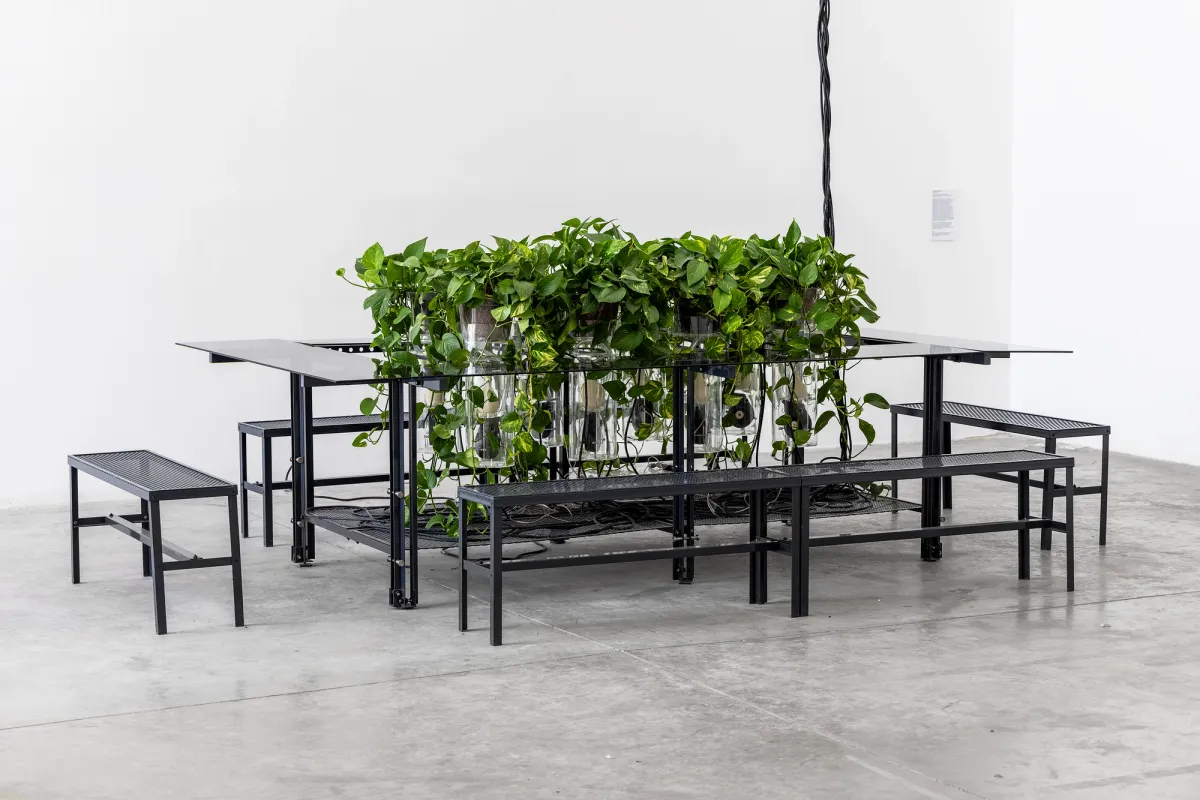
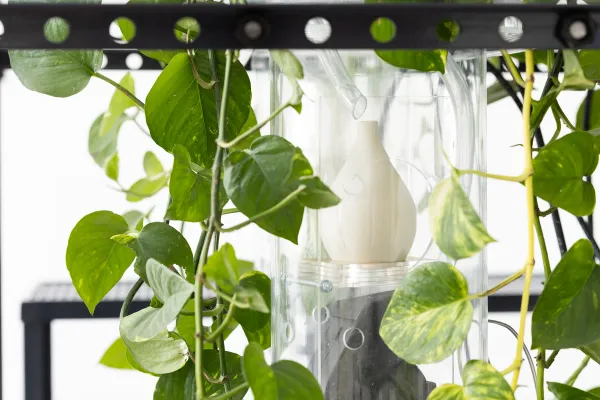
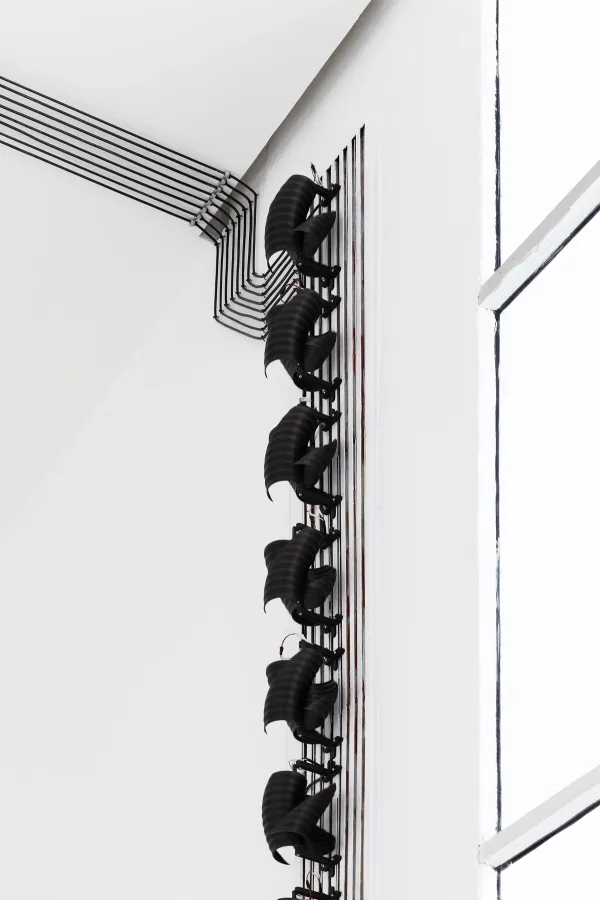
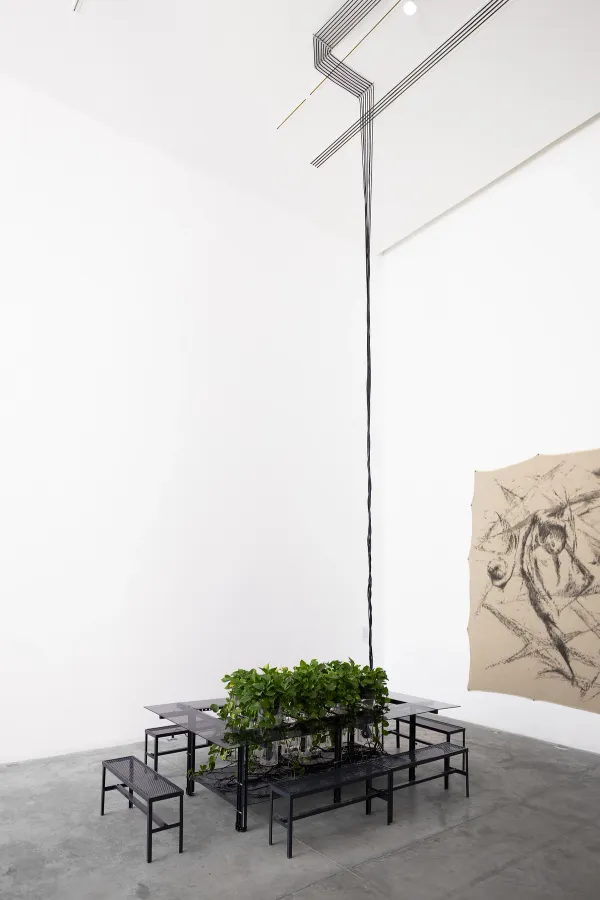
HIDROARPA is a large-scale hydraulic installation that generates sonic atmospheres for a plant ecosystem. A participatory fountain is activated by the presence of visitors. A system of sensors and electronic valves oscillates the falling water to produce music using hydrophones as reactive instruments. Developed in collaboration with composer Leslie García, the music is programmatically produced from the water flows as frequencies designed to stimulate specific plant behaviors. Inviting distinct listening experiences, this immersive instrument explores the ways in which diverse life forms perceive the physical dimension of sound.
Commissioned by Tequila Don Julio Exhibited at ACME 2025 Sound composition and generative programming: Leslie García Electronic and hydraulic development: Christopher Galicia Production direction: Eduardo Berumen Berry Industrial and architectural design: Ulises Morín Arzola Industrial design, manufacturing, and installation: Laboratorio Mexicano de Diseño (LMD) Vegetation: Botéo Graphic design: Andrea Volcán Variya Curatorial text (UN ARPA): Lorena Peña Brito Photos by Rubén Garay and Manuel Zuñiga
This exhibition explores the domestication of water and the environmental impacts of hydroelectric industries. Aiming to challenge the technical expectations of a variety of navigation technologies, a custom-made computer program interacts with satellite images altering a series of optical parameters in an attempt to disorient our gaze. Projected onto a layer of vapor generated by a large-scale humidification system, a video installation tells the story of the Tietê River, a body of water that has undergone violent processes of rectification of its meanders. The liquid dispersed in the environment destabilizes the material distinction of rivers as phenomena separate from more subtle water manifestations.
Curated by Marielsa Castro Vizcarra Software design by Alberto López Sound design by Luisa Lemgruber Translation Spanish-Portuguese by Ana Roman Edited in Portuguese by Mônica Hoff Voice by Julia Sampaio Alves Correa Ceramics by Ana Rivera Photos by Rubén Garay and Noemi Garcia
The exhibition was presented at PEANA in Mexico City. An earlier iteration was exhibited at AYER AYER in Guadalajara, Mexico.

.jpg?w=600&fm=webp)





Materia Abierta is a summer school on theory, art, and technology taking place in Mexico City with the intent of mobilizing critical thinking and political will. Each edition of the program generates new contexts for learning based on principles of collectivity. Participants have included Suely Rolnik, Awilda Sterling-Duprey, Ochy Curiel, Fernando Palma Rodríguez, Black Quantum Futurism, Michael Marder, Clapperton Chakanetsa Mavhunga, Denise Ferreira da Silva, Luciana Parisi, Brigitte Baptiste, Ramon Amaro, Reza Negarestani, Verónica Gago, Xuno López Intzín, Maximiliano Mamani, Sidarta Ribeiro, Yásnaya Elena Aguilar Gil, Vaginal Davis, Macarena Gómez-Barris, Vanessa Machado de Oliveira Andreotti, Gladys Tzul Tzul, among many others.
Materia Abierta is a collective effort developed with Ana Rivera, Eva Posas, Zoë Heyn-Jones, and Mayté Valencia. The program has been curated by Nataliza Zuluaga (2019), Mônica Hoff and Eva Posas (2021), Sara Garzón (2022), Jorge González Santos (2023), Camila Marambio (2024). It has been hosted by Universidad Nacional Autónoma de México (UNAM), Museo Tamayo, Museo Universitario Arte Contemporáneo (MUAC), Casa del Lago UNAM and supported by organizations such as Cátedra Max Aub, Programa Arte Ciencia y Tecnología (ACT), KADIST, NORO, PEANA, and Universidad de Monterrey UDEM.








This essay explores the ever-evolving geometry of the Rio Grande/Río Bravo and with it of the U.S.-Mexico border. It revises the history of its persistent transformation and the implications of the river performing as border technology — one that expands and contracts beyond the immediacy of human temporal and spatial scales. The border is permanently negotiated where each act of measurement allows for the recalibration of the authority exercised over it. Such instability, paradoxically, generates the conditions that are used to justify the application of force on its limits — the operational regimes that violently reinforce the river as an artificial boundary.
Published by The Serving Library Edited by Francesca Bertolotti-Bailey, Stuart Bertolotti-Bailey, Vincenzo Latronico, David Reinfurt, and Robert Wiesenberger
This is the second installment of a mini-series focused on the influence of reading machines as interactions are persistently captured by computational systems. This essay reflects on the increasingly recursive nature of communication as information platforms attempt to improve based on real-time processing of online content. It aims to identify modes of illegibility capable of challenging the sight of machines and move our understanding of communication beyond comprehension and towards what Édouard Glissant called a “poetics of compromise.”
Written in collaboration with Nic Schumann Coordinated by Ben Schwartz Published by Source Type
Exploring the gap between objects and their representations in the age of computational deception, this text takes as its starting point the operational nature of images. It describes the unstable production of reality and the capacity of events to dislocate from space through their artificial presence in real time. In a context where the algorithmically calculated future and the quantified past seem to merge, the plausibility of an action has more impact than its concrete manifestation. Such representational instability produces a kind of blindness based on the presumed computational objectivity and excessive faith in data.
Written in collaboration with Chris Hamamoto Commissioned by Naief Yehya Published by Luna Córnea
As part of the Museo Tamayo’s educational program, Materia Abierta was invited as a resident project to share its bibliographic collection and other materials that have informed our pedagogical practices. The gallery walls displayed a series of diagrams — spatializing some of the themes explored during the Materia Abierta’s editions. These sketches reflected the investigative concerns resonating collectively within the school’s organizing team. Throughout the residency, various activities were developed around practices that explore the possibility of sustainable worlds and the independent production of publications for the circulation of knowledge endemic to specific territories.
Sala Pública was a project developed collectively by Materia Abierta. It was commissioned by Rubí Gokigenyo and coordinated by Saúl Quiroz from Museo Tamayo. Participants included: Enero y Abril, Yunuen Díaz, Preciosa Sangre, Alejandra R. Bolaños and Sebastián Agulló, Axel Dechelette Ramon and Javier Guzmán Cervantes, Miguel Cinta Robles, Trama Mutua, Bárbara Lázara, Torrivilla, Wirunwan Victoria Pitaktong. During the residency, a live radio program was organized with Montez Press Radio, curated in collaboration with Fabiola Talavera. Participants included: Climate Collapse, Primal, Calpulli Tecalco, Elsa Valiente, Organización Popular Francisco Villa de la Izquierda Independiente, Futuros Indígenas, Camila Marambio, Michy Marxuach, Tania Ximena and Carlos Edelmiro, Panósmico and María Goded, Guillermo Canek García, Leslie García and the Archivo Familiar del Río Colorado.
Photos by Rubén Garay
This installation features a series of timelapses displaying flowers blooming and decaying with auto-generated captions added by a custom-made program. The project explores the in-transferability of meaning between images and text and the politics behind organizing visual content into semantic structures. A technical reenactment of NeuralTalk, an early model designed to write sentences that describe images, this adaptation exposes the limits of object recognition technologies — its inaccurate outcomes make explicit the unstable relation between images and their conceptual representations. By applying the software to videos of plants in stages of transformation, this exploration makes cite of the anthropocentric mischaracterization coded into computers and the limited capabilities of machine vision when confronted with information that falls outside of a specific worldview.
Developed in collaboration with Chris Hamamoto Curated by Diane Hau Yu Wong Commissioned by Henry Heng Lu Software development by Greg Monroe Sound engineering by Tiger Dingsun Special thanks to Dyana Kim, Ellie Chung, and Soyeong Park Developed with support from British Columbia Arts Council and Seoul National University




This essay recovers Gustavo Esteva’s ideas on the deprofessionalization of learning and the possibility of escaping from education as a pillar of colonial modernity. It exposes the principle of scarcity as the economic pulse that organizes capitalist societies and the homogenizing violence of schools as producers of meritocratic fictions. It also explores how, through linguistic devastation, schooling has impeded the continuity of the endemic knowledge of Mesoamerican communities and the sustainable care of their territories.
Commissioned by Miguel Braceli Edited and translated by Marianela Díaz Cardozo Published by LA ESCUELA
This essay takes as a starting point our visit to the Anfu Market in Putian to explore the automatic policing of counterfeit products online by tech companies. It investigates the alteration of digital images within marketplaces as a strategy adopted by sellers of replica products to avoid detection and escape bots that seek suspicious items. Focusing on the identification of brands within Amazon the text seeks to understand the mathematical spectrum that defines the geometric nuances of images and the legal frameworks designed to protect their perceived originality as intellectual property. The essay, ultimately, investigates the mechanisms through which value is extracted from images as software is able to infer their contents, effectively expanding the legal implications of metadata.
Written in collaboration with Chris Hamamoto Commissioned by Johanna Mehl Published by ADOCS
The Library of Imagined Symbols (LOIS) is a collection of fictional symbols in literature. It archives text descriptions of marks representing entities within nonexistent societies — from holographic logos across Tokyo-Bay in William Gibson's Neuromancer, to David Foster Wallace's cartoonish Mister Squishy, to Ayn Rand's dollar signs stamped in gold on cigarettes. The library studies the symbolic power of graphics as they render as mental images in the collective imagination.
Developed in collaboration with Ian Keliher. LOIS was presented in 2018 as part of All Possible Futures: Unrealized Archive at the Institute of Advanced Uncertainty in San Francisco, United States. In 2023 it was materialized as a small physical library as part of Text to Image, an exhibition curated by Chris Hamamoto and Jon Sueda at WRM in Seoul, South Korea.




This text presents a series of ruminations, divergent reflections, around the imprecise exercise of organizing Materia Abierta, a prototype school that overflows beyond linear temporalities. Accompanied by a series of diagrams that set in motion conceptual relationships involved in escaping these time traps, the essay focuses on the principle of recursivity to address the ethics of future-presents that are yet to emerge.
Published by DELUS Edited by Johanna Just and Sara Frikech
This is the first installment of a mini-series focused on machine reading and modes of illegibility. It recovers the history and development of OCR technologies, to ultimately propose an understanding of letterforms as images and images as programmable artifacts with the capacity to manipulate computational infrastructure and surveillance pipelines.
Written in collaboration with Nic Schumann Coordinated by Ben Schwartz Published by Source Type
This work brings us closer to the museum apparatus itself as an economic context: a mural arrangement presents us with color variations resulting from the attempt to match the synthetic terracotta tone present in the museum's architecture through commercial color formulas. In addition to this particular operation a video anecdotally reassembles memories from the museum's staff regarding events related to the company responsible for sponsoring the painting of the venue and its desire to use these same walls as a set for an internal corporate photo shoot. Between the regulation of an earthy tone that alludes to both the landscape and the idealized assimilation of traditional aesthetics within modern Mexican architecture, the present of the museum is revealed as a complex vortex: a continuous oscillation between the artifice of modernity, the colonial traces of neighborhood in which the building is located, the incessant winds of the northeast and the always complex link that the city of Monterrey in Mexico maintains between its cultural institutions and the private sector.
Curated by Ana Pérez Escoto Mural execution by Alfonso Cavazos Voice acting coordination by Celina García




In a context where digital images carry out algorithmic functions that are not possible to observe, this exhibition takes its title from what researcher Luciana Parisi calls “negative optics.” It engages with the negative materiality of images as an epistemic possibility from which to reassess the dominance of vision as the axis of truth at the scale of capital. Bringing together a group of artists exploring the production of images as tactical evidence to events, objects, spaces that have been deliberately obscured, the exhibition calls into question how the perpetuation of violence, and its representation, is in the interest of the current configuration of regional power.
Curated by Federico Pérez Villoro Commissioned by Constant Dullaart Exhibited by Distant Gallery and Casa del Lago Website design and development by Kit Son Lee
Participating artists: Sergio Beltran-García, Andrea Carrillo Iglesias, Gerardo Contreras, Débora Delmar, Juan Arturo García, Julieta Gil, Daniel Godínez Nivón, Geraldine Juárez, Fabiola Larios, Karla Leyva, Jorge Palacios, Jerónimo Reyes-Retana, Andrew Roberts
Transparencia Index is a custom-made platform that automatically scrapes data from the Plataforma Nacional de Transparencia, a system through which people can request public information from the Mexican government. The software identifies existing requests associated with topics of common interest that were previously denied on the basis of containing information classified by authorities. This ever-increasing flow of unanswered civic concerns are organized as an interactive website that aims to register, through labyrinthine hyperlinks, the bureaucratic opacity and strategic silence of the country’s administrative institutions.
Software development by Agnes Cameron Web design and development by Tiger Dingsun Commissioned by Printed Matter + EXILE Books for NADA Miami 2021
The piece was shown as part of This is Life at Palm Springs Art Museum in Palm Springs, United States, an exhibition curated by Robert Kett in 2023. An earlier iteration of this project was developed for the exhibition Cartografías Ocultas: Circuitos del Arte Correo en México at Museo de Filatelia de Oaxaca, curated by Pedro Ceñal Murga and Alfonso Fierro.




During this performance, a series of poems generated in real time by a system designed to imitate the poetic style of Rosa Espino, an imaginary poet who served as a pseudonym to general Vicente Riva Palacio, was read collectively. Giving continuity to this historical act of literary deception, a computer program analyzed the vocabulary, themes, and grammatical structure of the body of work authored by Rosa Espino to generate new texts. For this event organized in a domestic patio, the system produced passages with floral motifs that were read by local poets and the attending audience.
The software was developed in collaboration with a team from the Instituto de Investigaciones en Matemáticas Aplicadas y en Sistemas (IIMAS) of the Universidad Autonoma Nacional de México (UNAM), coordinated by Ivan Vladimir Meza Ruiz. The performance was presented by PEANA and PAOS GDL during Estación Material, Vol 1 in Guadalajara, Mexico in October 2021. The website for the event and poster was designed by Tiger Dingsun and edited by TOMO Ediciones.
Photos by Ernesto Solana





This article studies the first large scale surveillance system with facial recognition installed at a governmental level in Mexico. The investigation reveals a series of technical and legal inconsistencies in its implementation as it documents the cooperation across the border between intelligence agencies and indirect use by the FBI of a technology that was blacklisted by the United States. The promise of security is once more a political tool that responds to local commercial interests and that ultimately threatens the rights of citizens.
Written in collaboration with Paloma Robles Published by Quinto Elemento Lab
This work investigates the possibility of adding to Google Maps a monument that does not exist. An interactive website displays 3D scans developed with Julieta Gil from fragments of the monuments of the Calzada de los Poetas in Mexico City. As an illustrated tale, a voice tells the story of a man searching for an image from his past: a monument to Rosa Espino, an imaginary poet used as a pseudonym by general Vicente Riva Palacio to write poetry. Traveling through the city and its digital maps, the character reflects on the institutional mechanisms through which memory and history are constructed within the limits of information devices.
3D models by Julieta Gil Web design and development by Tiger Dingsun Copyediting by Isabel Zapata Voice by Paula Villanueva Ordás Commissioned by Casa del Lago UNAM
A printed version of the project was included as part of La Hibridez en Potencia, a book published by Casa del Lago in 2022.
Published as a sort of editorial parasite, this piece explores the boundary between the production of an image and its reproduction. The paintings were commissioned in Dafen, China, a town dedicated to the commercial making of oil copies. This form of production reflects a broader ecosystem where intellectual property is not protected but rather technical knowledge is shared to contribute to common development. Taken from La Jetée, a film by Chris Marker about the possibility of time travel through pictures, this frame is reproduced irregularly throughout the pages of the magazine. The repetition of the paintings in the publication challenges our capacity to notice their subtle variations — making us see images we have seen before but recognize them as different.
Commissioned by Lucia Hinojosa Gaxiola and Diego Gerard Published by diSONARE
In a landscape where the technologies governing our lives are increasingly obscured, this publication aims to reveal the underlying processes of a machine learning program. It seeks to mediate machines' sight and human comprehension. The book documents the technical capacities of an algorithm trained to analyze the formal patterns of the alphabet while it imagines other letters from that knowledge. The resulting outputs — letters without semantic value — embraces and emphasizes the meaningless results of the machine: it is the human input and framework that imbues sense to these forms.
Developed in collaboration with Nic Schumann Book design by Marie Otsuka Published by Gato Negro Ediciones
Interested in investigating the possibilities of technology approaching the materiality of language, Federico Pérez Villoro developed a program that recognizes the formal patterns of the alphabet and imagines new letters from that knowledge. The results are presented in this exhibition as characters that transform into ethereal mutant entities leaving vaporous traces of that which came before with each variation. Although this process is the foundation of his research, this exhibition is not limited to a mere typographic work. It is, rather, the origin of an exploration of the language of chimeras formed by humans and machines.
—Paulina Ascencio Fuentes
Curatorial text by Paulina Ascencio Fuentes Software developed by Nic Schumann Production coordination by Eduardo Berumen Photos by Michelle Lartigue

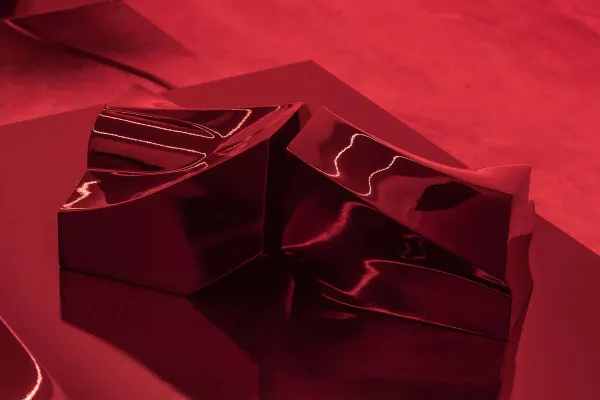



This essay uses a centuries old manuscript on the occult that hides sophisticated ciphers to explore our changing relationship to what societies consider to be magical. It studies how magic has shifted over time from being prohibited within societies ruled by religion to being wielded as a tool for commerce by techno-governing bodies. The text charts how the unknown has taken on new faculties when evoked to entice consumers with technologies that work beyond our understanding, but also as a strategy to obfuscate the inner workings of computational products. It ultimately looks at the intertwining of State and corporate powers, as private companies increasingly take on civic roles — determining the spaces and grammars through which knowledge is built and the perception of what is real is permanently negotiated.
Written in collaboration with Chris Hamamoto Commissioned by Ali Qadeer and Chris Lee Published by C Magazine
These works explore the impact of machine vision models used to identify people, and the datasets with which they are trained. Putting into question the very act of organizing images as conceptual classes, they address both the in-transferability of meaning between images and concepts and the amplification of social biases always present in such a process. Under an ongoing search for what we understand as “fugitive images,” these explorations are artifacts at the margins of algorithmic vision and speculate on the possibility to escape the logics of computational representation.
Developed in collaboration with Chris Hamamoto Software by Nic Schumann






Gradually moving from English to Spanish, two performers demonstrate examples of speech hesitation phenomena as they aim to translate puzzling “nonsense” poems. Through filled and unfilled pauses, invented words, and other paralinguistic markers, performers spontaneously engage with the text structures as they express the spaces between semantic interpretations.
A Lexicon of Hesitation was performed in 2018 as part of Almost Solid Light, an exhibition curated by Mario Navarro at Paul Kasmin Gallery in New York City. It was interpreted by Emily Davis and Nicolas Norena. Styling was overseen by Sofia Beas. Cynthia Ventura advised on the topic of simultaneous interpretation. The script was edited by Mariana Pérez Villoro. The print was made in collaboration with Ana Rivera and Tiger Dingsun.
This publication explores a form of steganography embedded in most commercial printers. In addition to the intended content, many printers secretly encode metadata as a pattern of matrices of near invisible yellow dots. The project investigates the presence of such codes in a NSA classified report that was leaked to a news media outlet. Posted online as a scanned PDF, the document had such encrypted marks with a timestamp and the serial number of the machine that was originally used to print it. Shortly after the report’s publication, the Justice Department charged Reality Leigh Winner, an Air Force veteran and NSA contractor, under the Espionage Act. This technology has been enforced by the U.S. government to prevent counterfeiting and make printouts forensically traceable. However there are no clear regulations around it nor wide knowledge of its uses — becoming a threat to anonymity and political dissidents. The publication includes instructions to decode the yellow dot pattern as it explores the legibility of yellow ink over different lighting conditions.
Developed in collaboration with Chris Hamamoto. The publication was exhibited as part of Mage, an exhibition curated by Roxana Fabius at Radiator Gallery in New York in 2018.



This project features a program that struggles to clearly label color nuances in moving images. The piece explores the ways in which colors are organized semantically and the patterns within the history of when color terms appeared over time in different languages. More specifically, it focuses on the linguistic separation of what we now identify as “green” and “blue” and the roots of such distinction as a process of epistemic Western dominance and a result of the impact of industrial technologies on human perception.
Developed in collaboration with Chris Hamamoto. The piece was exhibited at A.I.R. in New York as part of Digressions, a research series on visual thinking organized by MGMT design.



This book is conceived as an experimental reprint of Futura, the seminal collection of concrete poems edited by Hansjörg Mayer. Enhanced with a custom made 3D-printed mechanism (or machine prosthetic) that enables automatic manipulations to the printer’s encoder strip, the book re-interprets the poems by means of mechanical mediation, outputting the originals through a set of controlled and chance operations. The resulting work is a set of new, altered text pieces that reflect on the elasticity of words within a printed page. The project explores the ability of language to deliver meaning at the boundaries of intentionality when text is pushed over into image or object as it is reproduced.
Developed in collaboration with Chris Hamamoto Introduction text by Roxana Fabius Project coordination by Keith Gray Published by Printed Matter
This project was shown at Double Negative, an exhibition in ChaShaMa curated by Darling Green in New York City in 2019. It was also exhibited at the Palm Springs Art Museum in 2023 at This is Life, curated by Robert Kett.
This piece consists of a performative reading of speech distortions produced by loops of computer to computer dictation of the Harvard corpus — a set of phonetically balanced sentences designed to hit all the possible sounds of the English language and as voice synthesis research during WWII. Two performers simultaneously read the erratic outcomes in the same sequence and inverse temporal logic.
Performed by María Fernanda Rosas Velasco y Humberto Domínguez as part of the exhibition You Are Here, curated by Adrián S. Bará in PEANA, Monterrey in 2017.


This essay explores the evolving landscape where branding operates as developments in technology blur distinctions between private and public entities. It analyzes how information platforms enable complex shifts in governance as state and non-state powers embrace surveillance, digital propaganda, and globally distributed networks of data, in their own brand strategies.
Written in collaboration with Chris Hamamoto Published by the Walker Art Center
(human) learning was a study group on technology and aesthetics with shifting participants, locations and collaborators. Organized around discussions of theory and fiction, the program addressed our collective anxieties around the distance between human cognition and the increasing complexity of computational systems. Each session was broadcast live on a website using a custom-made software that transcribed conversations as it learned to decode speech into text and images.
Developed in collaboration with Roxana Fabius. The group was hosted by P! inNew York City; ArtCenter/South Florida in Miami; ZONAMACO in Mexico City, and O.R.G. in New York City. The transcription software was developed by Chris Hamamoto.

This series of workshops and lectures focused on art and design practices that make use of computation as means and motifs for research and critical experimentation. The program investigated how the reproducibility of information, across a wide range of media, destabilizes the power of the singular art object and, in the process, reveals how institutional systems and market forces regulate the flows of knowledge.
Developed in collaboration with the Fundación Alumnos and Museo Tamayo. The website and graphic identity was designed by Chris Hamamoto.


































































